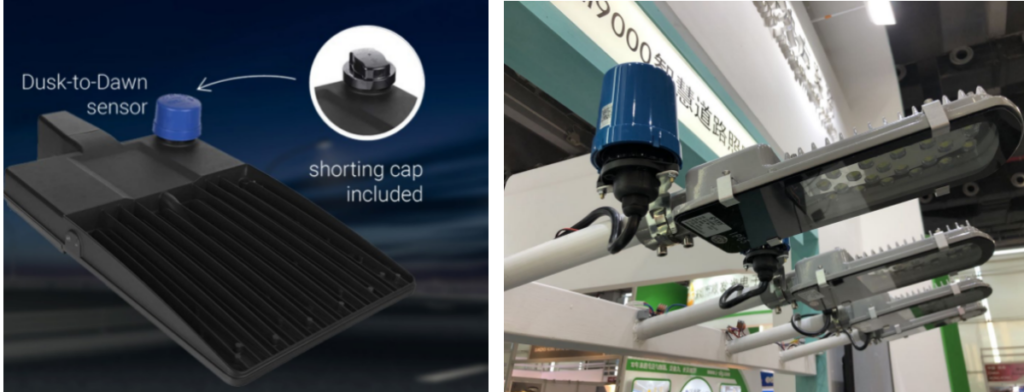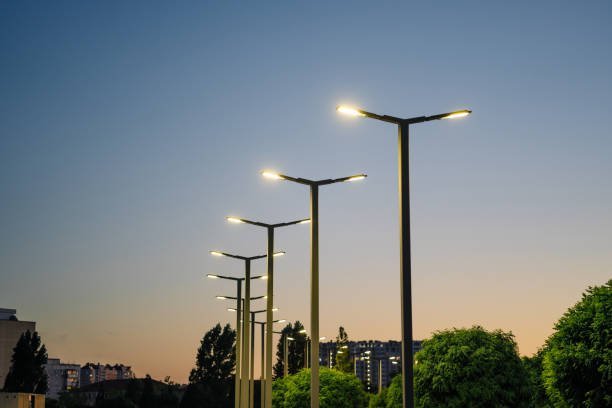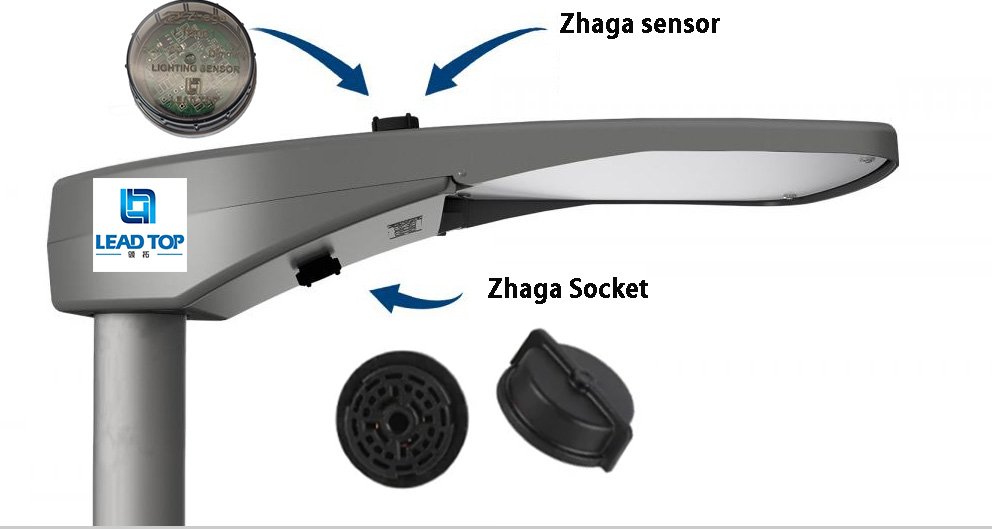Introduction
In today’s society, outdoor lighting is gradually ushering in a more intelligent and automated era. In this trend, photocells play a crucial role as a key technology, significantly enhancing the efficiency of outdoor lights and endowing them with more energy-saving and environmentally friendly characteristics. This article aims to delve into the different types of photocells used in outdoor lighting, their wide range of applications, and installation methods in luminaires, providing a comprehensive overview of the pivotal role of photocells in the outdoor lighting sector.
Definition and Function
Photocells, commonly known as photocells, are devices capable of sensing the ambient light intensity and responding accordingly. In outdoor luminaires, the key function of photocells is to automatically control the luminaire’s switch based on changes in ambient light, enabling the lighting system to intelligently manage light conditions.
Applications,Types,Installation Methods, and Advantages
Street Lights
Photocell Product Types: Mainly twist-lock photocells
Installation Scenarios: Public space lighting, sports venue lighting, bridges, parking lots, airports
Installation Methods & Locations:
– Installation Methods:
- Directly installed above the luminaire
- Installed on lamp posts, arms, etc.
– Installation Locations: Typically located at the top or side of the streetlight head to fully sense the surrounding ambient light.

Garden Lights
Photocell Product Types: (Wired & Twist-lock photocells)
Installation Scenarios: Outdoor home floodlights for garden pole lights, farms, chicken coops, orchards, barns, etc.
Installation Methods & Locations:
– Installation Methods:
- Directly installed above the luminaire
- Assisted installation on luminaire accessories such as brackets or clamps, or suitable scenarios for photocells.
– Installation Locations: Photocells are usually embedded in the lamp post or base of garden lights, or above the lamp box.

Wall Lights
Photocell Product Types: Wired photocells
Common Luminaire Types: Floodlights, sconces, up and down wall lights, etc.
Installation Methods & Locations:
- Installed directly above the luminaire, opening a hole above the luminaire to install the photocell inside
- Assisted installation with brackets or clamps near the luminaire, mainly for small-sized luminaires or outdoor luminaires with inconvenient holes.

Porch Lights
Photocell Product Types: Wired photocells & Lamp head photocells
Common Luminaire Types: LED bulbs, incandescent bulbs, fluorescent bulbs, halogen bulbs, high-pressure sodium bulbs, metal halide bulbs, etc.
Installation Methods & Locations:
– Lamp head photocells:
- Twist-lock
- Push-button – spring-loaded photocells
– Wired photocells: 1. Installed fixedly on the wall edge with aluminum plates

Landscape Lights
Photocell Product Types: Twist-lock photocells & Wired photocells
Common Luminaire Types: Pole-mounted landscape lights, string lights, ground plug-in landscape lights
Installation Methods & Locations:
- Installed directly above the luminaire, opening a hole in the luminaire
- Installed at the front/start end of the light string

Advertising Light Boxes
Photocell Product Types: Primarily wired photocells & Twist-lock photocells
Installation Methods & Locations:
- Directly drilled, installed on top of the lightbox
- Installed on railings or nearby places with other supports
- Using aluminum plates, install the photocell at the porch for lightbox signs hung on the porch.

Advantages:
Energy-saving and environmentally friendly:
Photocells can intelligently control luminaire switches based on changes in ambient light, automatically turning them off during the day or in sufficient light conditions, saving energy. This automatic adjustment significantly reduces energy consumption and is more environmentally friendly.
Extended luminaire lifespan:
Intelligent control by photocells can avoid unnecessary luminaire usage, reducing the luminaire’s operating time and thus extending its lifespan. This helps reduce the frequency of luminaire replacement and maintenance costs.
Automated management:
Photocells realize the automated management of streetlights without the need for manual intervention. They automatically adjust lighting at sunrise and sunset without human operation, improving the efficiency of streetlight management.
Social safety:
Photocells ensure that outdoor luminaires automatically turn on during nighttime or low light conditions, enhancing road and community safety. This positively affects reducing nighttime accidents and crime prevention.
Meeting lighting needs:
Photocells can achieve automatic dimming of outdoor luminaires based on different light intensities. They increase lighting brightness in darker conditions and moderately reduce it in brighter conditions to better meet lighting needs at different times.
Saving maintenance costs:
The automation and remote monitoring functions of photocells reduce the daily maintenance costs of outdoor luminaires. It not only reduces the need for manual operations but also enables timely detection and resolution of issues through remote monitoring.
In conclusion, by installing photocells, outdoor luminaires can achieve more intelligent and efficient lighting management, bringing multiple advantages such as energy-saving, environmental protection, and safety.
Technological Innovation and Future Trends
Smartization Trend:
- Expansion of IoT Applications:
With the rapid development of the Internet of Things (IoT), outdoor luminaires are not just lighting devices but can also become part of smart city infrastructure. The integration of IoT technology enables outdoor luminaires to collect, analyze, and apply data more extensively, providing cities with smarter and more efficient services.
- Smart City Ecosystem:
The smartization of outdoor luminaires becomes an integral part of building smart city ecosystems. Through linkage with other smart devices in the city, such as intelligent traffic systems and environmental monitoring devices, outdoor luminaires can respond more accurately to urban needs, improving the overall management level of the city.
- Smart Energy Management:
Smart outdoor luminaires can improve energy efficiency through real-time energy monitoring and adjustment. The development of technologies such as adaptive lighting control, energy storage, and solar integration enables outdoor luminaires to be part of sustainable energy use, driving smart cities towards greener directions.
Efficiency Enhancement:
- High-efficiency Energy Conversion Technology:
Continuous advancements in photocell technology, including more efficient energy conversion and storage technologies, enhance the energy utilization efficiency of outdoor luminaires during use. This means that luminaires can provide lighting services for longer periods under limited light conditions.
- Smart Dimming and Timed Control:
Advanced efficiency enhancement technologies include smart dimming and timed control functions, which can adjust in real-time based on ambient light conditions and actual needs. Such intelligent control not only improves lighting effects but also reduces energy waste.
- Integration of Sustainable Energy Sources:
Integrating outdoor luminaires with renewable energy sources (such as solar energy) through photocell technology enables more effective conversion of solar energy, providing outdoor luminaires with independent and sustainable energy sources, thereby reducing reliance on traditional electricity.
- Energy Efficiency Standards and Certifications:
Energy efficiency standards and certifications for outdoor luminaires continue to rise within the industry, encouraging manufacturers to adopt more efficient technologies, thus driving the entire industry towards more environmentally friendly and efficient directions.
More development trends and technological innovations in the fields of smartization and efficiency enhancement provide broader development space for the future of outdoor luminaires.
Conclusion
Through the exploration in this article,we have gained a thorough understanding of the applicability of photocells in outdoor lighting. Understanding which types of luminaires photocells are suitable for and in which scenarios they are most appropriate will aid in achieving the intelligence of outdoor lighting. By flexibly selecting photocells with different functionalities, we can tailor lighting systems that are aesthetically pleasing and meet our individual requirements. Such intelligent designs not only make life more convenient but also provide viable solutions for energy efficiency, achieving a more environmentally friendly lighting effect.







